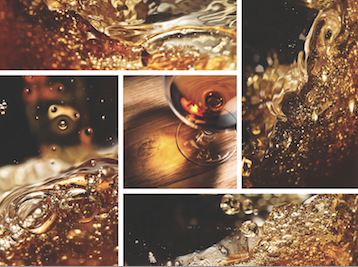Despite tough trading conditions in Russia at present, Moore says: “Overall, there is positive momentum around Ballantine’s Finest in Russia. As in Brazil, we’ve been involved in music-related activities in Russia, and we are also employing music activation in South Africa and Angola. In South Africa we collaborate with the famous DJ Black Coffee, using him in advertising and digital media. We’ve seen real momentum for Finest as a result.”
Another factor in the comparatively positive trajectory for Ballantine’s has been a repackaging exercise for Finest, accompanied, as Moore says by “putting positive energy into point of sale displays, which seems to be paying off”.
Another leading blended brand which has benefitted from repackaging is Dewar’s – the best-selling blended scotch in the US. Last year saw the range receive a major overhaul, with brand activity focusing on the slogan True Scotch Since 1846.
According to a Dewar’s spokesperson: “Under the banner of True Scotch, the new Dewar’s visual identity is designed to intrigue and engage consumers in the most direct way possible – bringing the values, aspirations and authenticity of this unique whisky to life, while showing how relevant these qualities remain.”
Bacardi global marketing manager for whisky Stephen Marshall adds: “The relaunch has been global, so it takes time to bleed through the system, but we’re seeing really positive signs in the US and Spain, two of our most important markets.”
It is impossible to consider the role of blended scotch on the global stage without considering Chivas Regal, and a Chivas spokesperson declares: “There has been good brand performance in the key growth markets of Brazil, India, Turkey, Mexico, South Africa and Australia, and also in mature markets, including France.
“Chivas Regal is ramping up its activity globally, employing Win The Right Way – our biggest integrated campaign yet, supported by The Venture, the founding of a $1million fund for social entrepreneurs.”
Last year also saw the release of the first new Chivas Regal blend since 2007 in the shape of Chivas Regal Extra, which employs a higher than usual percentage of sherry cask-matured whiskies in its composition, and which takes its place in the brand’s super-premium sector.
So much for the activities of some of the key blended scotch brands in export territories, but one blended scotch market that is rarely mentioned in positive terms by producers at present is the UK.
Since 2009, the overall UK market for malt and blended scotch whisky has fallen by some 9.5%, according to HM Revenue & Customs figures, and established blends have borne the brunt of that decline.
However, it is not all doom and gloom, as Compass Box supremo John Glaser observes. “Our business is up around 25% in the UK and much of that growth comes from our Great King Street blends. This follows several years of significant UK growth for us.”
The ‘niche’ Great King Street blends depart from more conventional offerings by giving the consumer far more information than most blenders would ever dream of disclosing, including the identity of component whiskies and the maturation regimes involved in their development.
In terms of the decline of traditional blends in the UK, Glaser says: “I see it as a brand issue rather than a blend issue. The big name blends don’t have any relevance to younger people. If you present the right blend to the right people in the right way, it will sell.”
In these still challenging times, the global art of presenting ‘the right blend to the right people in the right way’ has arguably never been so important.




